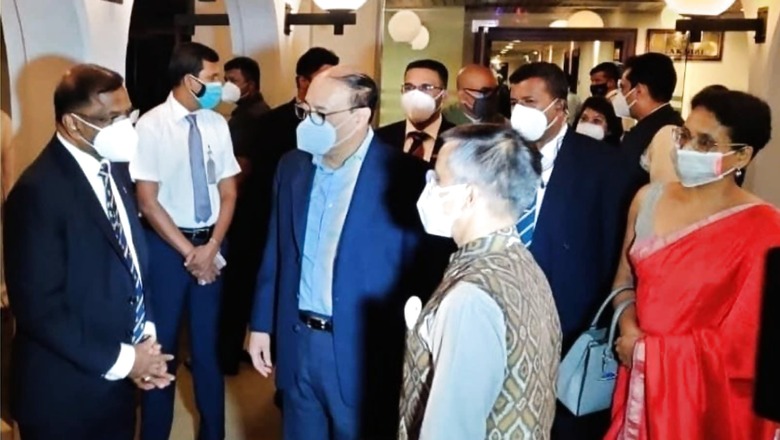
views
President Gotabaya Rajapaksa had chosen India for his first visit abroad upon assuming office in November 2019 when he pledged to “strive to elevate Indo-Sri Lankan relations to the highest level possible”. This was viewed as a positive development given that in 2013, as defence secretary, he had alleged India’s role in destabilising Sri Lanka — “Had India acted responsibly, Sri Lanka would not have experienced a 30-year war, and India [can] never absolve itself of the responsibility for creating terrorism in Sri Lanka.”
Contrast it with the very first sentence in the statement issued by the Sri Lankan presidential secretariat on October 5: “President tells (visiting) Indian Foreign Secretary — Let’s rebuild the relationship between the two countries that existed in the 60’s and 70’s.” Foreign secretary Harsh Vardhan Shringla had called on the Sri Lankan leader. Such a remark by the head of state of the host nation is somewhat unusual and not a very subtle way of conveying that more needs to be done to infuse warmth in the ties.
ALSO | How India Lost Sri Lanka to China—Starting with Strategic Blunders during Indira Gandhi Regime
The deadpan statement was bereft of the usual diplomatic niceties. It referred instead to bilateral issues and Sri Lanka’s relations with China. The president did extend an invitation, though, to Indian investors. Gotabaya had “expressed his pleasure to meet” even with a BJP member of parliament earlier this month when the discussion was described as cordial by the secretariat.
Clearly, long-standing bilateral issues apart, China’s rapidly growing economic footprint (and political clout as a corollary) in Sri Lanka is straining India-Sri Lanka relations. China is already the largest investor in Sri Lanka, accounting for 23.6 per cent of the total FDI during 2010-2019 as against 10.4 per cent from India. China is also one of the largest export destinations for Sri Lankan goods and holds over 10 per cent of its external debt.
The Rajapaksa brothers are known to be close to Beijing, which is rumoured to have supported the re-election campaign of prime minister Mahinda Rajapaksa in 2019, in all manner. Mahinda on the other hand had blamed India’s intelligence agency among others for his defeat in January 2015, stating, “It was very open; Americans, the Norwegians, Europeans were openly working against me, and RAW.” Even so, to his credit, India was not made an issue during his 2019 re-election campaign.
Even though the previous Maithripala Sirisena regime was instrumental in leasing the sensitive Hambantota port to China on a 99-year lease, Beijing was rooting for the brothers.
Gotabaya has assured on more than one occasion that “Sri Lanka would not be allowed to be used for any activity that could pose a threat to India’s security, since there is a clear understanding about the geographical location of the two countries”. He also “explained the relationship with China in a comprehensive manner and informed the Indian Foreign Secretary not to have any doubts about it”. However, the ground realities are not very comforting for India.
It is well known how Sri Lanka reneged in February 2021 on an India, Sri Lanka and Japan trilateral Memorandum of Cooperation (MoC), to develop and operate the East Container Terminal (ECT) of Colombo Port, on the specious ground that public opinion was opposed to it. This was despite external affairs minister Subrahmanyam Jaishankar’s meeting and intervention with Gotabaya a few days earlier.
To contain the damage, Sri Lanka Ports Authority (SLPA) concluded a deal with India’s Adani Group to jointly develop the West Container Terminal (WCT) at the Colombo port, on a 35-year build-operate-transfer basis.
But next, Sri Lanka awarded a contract for installing hybrid renewable energy systems on the islands of Delft, Nainativu and Analaitivu near Jaffna to a joint venture of Chinese companies. The islands are just 20 nautical miles from Rameswaram (India) and can easily be used as a listening post. Speaking earlier in 2018 to a leading Indian daily, Gotabaya had remarked that India “has to come out of this ‘China phobia’ with regard to its relationship with Sri Lanka”.
Regardless, there is no denying that Sri Lankan comfort level — both of the public and officialdom — especially when it comes to big projects, is higher with China than India. Indian developmental projects do take much longer to be implemented, which dulls the sheen of the good work we are doing in our neighbourhood and beyond.
Take for example India’s humanitarian gesture of announcing 50,000 houses for internally displaced persons in Jaffna area in 2010 (an additional 10,000 were promised in 2017 during PM Narendra Modi’s visit). Granted that there were constraints (there always are), it is difficult to justify a lead time of 5 to 10 years for their construction. I am personally witness to the needless procedural wrangles we got into in the initial years. And, to be clear, we are talking of small and simple dwelling units mostly using local material and manpower. Willy-nilly the beneficiary nations have now also started comparing us with China when the difference appears to be even starker.
There are a number of other complicated issues that are casting a shadow on the ties, including the implementation of the 13th amendment of the Sri Lankan constitution, which envisages devolution of necessary powers to the provincial councils to address the just demand of the Tamil people for equality, justice, peace, and respect within a united Sri Lanka. Successive governments have dragged their feet on one excuse or the other. President Rajapaksa is on record having stated that he won without the support of the minorities. India is caught between a rock and a hard place. Neither can she ignore the legitimate aspirations of the Tamilian minorities nor can she push Colombo beyond a certain point.
On the brighter side, there are strong cultural linkages, including the bond of Buddhism between the two neighbours. The largest number of international tourists to Sri Lanka are from India. New Delhi has been trying hard to enhance bilateral connectivity and has been the first responder in times of distress for Sri Lanka. Even so, a perception remains among a section of the majority Sinhala community that India is an interventionist power.
There is no gainsaying that a subterranean trust deficit exists between India and Sri Lanka. The Rajapaksa brothers, who were instrumental in decimating the LTTE and ending the 30-year civil strife, with India’s understanding and support, remain suspicious of New Delhi and desire a visible Chinese presence as insurance. China is only too happy to oblige.
Yet the fact of geography is not lost on either side. Neither Sri Lanka nor India can afford to have strained ties. However, as a much larger country, the onus is on India to carry Sri Lanka along. We must be extremely patient and avoid reacting to any pinpricks. We need to engage Sri Lanka even more regularly and closely, especially at the highest levels.
We could step up our people-centric developmental activities while scrupulously staying clear of any interference in Colombo’s domestic affairs. So long as our security interests are not disturbed, we need not react to Chinese advances, which we cannot prevent in any case without causing a lot of rancour. Given Beijing’s authoritarian disposition, our friends will realise sooner than later that all that glitters may not be gold.
The author is Former Envoy to South Korea and Canada and Official Spokesperson of the Ministry of External Affairs. The views expressed in this article are those of the author and do not represent the stand of this publication.
Read all the Latest News , Breaking News and IPL 2022 Live Updates here.

















Comments
0 comment